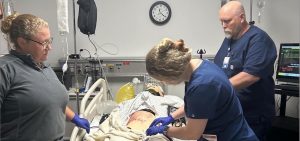News
Local nurses get critical trauma care training with lifelike ‘patients’
By: Gabriel Scotto
Posted on:
ATHENS, Ohio (WOUB) — A group of nurses stand huddled around a patient who was rushed to the emergency room after their tractor rolled over. The patient has multiple lacerations to the torso, a serious head wound and is being administered oxygen.
 The patient lets out a pained groan as one of the nurses places an IV into their vein and screams when one of the nurses attempts to treat the lacerations on their torso.
The patient lets out a pained groan as one of the nurses places an IV into their vein and screams when one of the nurses attempts to treat the lacerations on their torso.
Fortunately, the “patient” in question is a high-fidelity mannequin which is being manipulated by Lacey Douglas, simulation coordinator for the nursing program at Ohio University. These mannequins, which can cost up to $100,000, are used to train nurses and are capable not only of talking, but also have a pulse and bodily fluids and can even be made to bleed and have seizures.
“We’re able to take what our nursing students learn in the classroom, then practice on these ‘patients’ before they go out into the community and give them real-life experience before they go into a hospital setting,” Douglas said.
The nursing staff treating this plastic patient aren’t nursing students, however. They are nurses from the emergency department at OhioHealth’s O’Bleness Hospital, who are being provided with trauma care training at Ohio University’s simulation lab in Grover Center.
“We reached out to Ohio University to start collaborating with them to provide training to our nurses and bring practical as well as advanced skills in the field of trauma,” said Jennifer Parks, administrative nurse manager of the emergency department at O’Bleness.
Given Ohio University’s longstanding relationship with OhioHealth, it was only natural that the university agreed to allow OhioHealth to use its simulation lab to provide its nursing staff with hands-on training.
“Simulations are important,” said John McCarthy, dean of the College of Health Sciences and Professions at Ohio University. “There’s a lot of ways that we can build skills for people before they lay their hands on a person.”
As O’Bleness is the only hospital within a 40-mile radius and the nearest trauma hospital is located in downtown Columbus, it is crucial for nurses at O’Bleness to be able to assess and stabilize patients who require advanced trauma care to prepare them for transport and ensure more positive outcomes.
Parks said it’s not feasible to train emergency department nursing staff in Columbus because of the need to keep the emergency department operating. Instead, OhioHealth has trauma educators from Grant Medical Center come down to Athens to train its nurses at the simulation lab.
“Having these resources in our backyard allows us to get everybody through training in a timely fashion,” Parks said.
Another benefit of using the simulation lab for training is that it allows nursing staff to practice techniques in a low-risk environment, while also giving them practical experience.
“Previously, (nursing staff) would have experienced a trial by fire, in which they’d be thrown into a high-stakes environment,” McCarthy said. “Now we can simulate what that feels like, but a person’s life isn’t literally on the line here.”
McCarthy said another benefit of undergoing this training in a simulated environment is that it gives nursing staff a chance to pause and reflect in a way they cannot in a real-world situation.
“You can never press pause when you’re out working in an emergency department. If they’re able to focus on a specific skill they need to spend a little more time on, I think everybody benefits from that,” McCarthy said. “If it means they aren’t experiencing burnout or they’re able to de-stress a little bit by having a chance to reflect, I think that helps them and the community too.”

